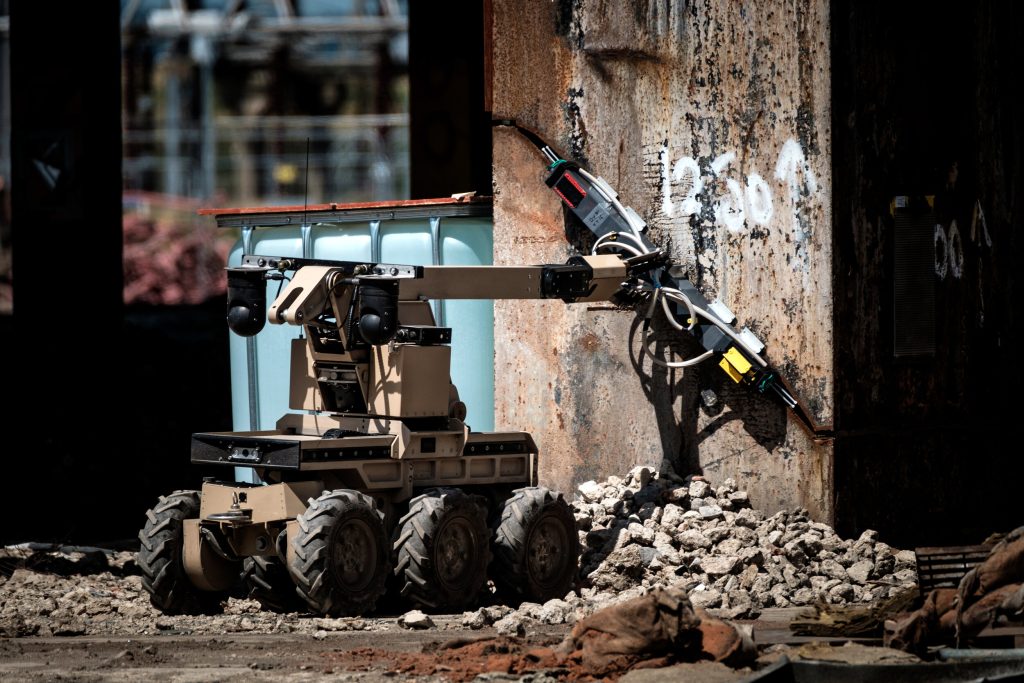Home >
Website Glossary
EOD Robot
A remotely operated vehicle equipped with cameras, sensors, and manipulator arms used by EOD technicians to inspect, handle, and dispose of explosive devices from a safe distance.
EOD Technician
Highly trained personnel responsible for identifying, assessing, and disposing of explosive threats, often working in high-stress and dangerous environments.
Explosion
An explosion is a rapid chemical reaction or change of state that generates high temperatures and usually produces a large volume of gas. This process creates a shock wave in the surrounding environment. The term ‘explosion’ encompasses both deflagration and detonation.
Explosive Booster
An explosive booster is a sensitive explosive charge that serves as a bridge between a relatively weak conventional detonator and a low-sensitivity explosive, such as TNT, which typically has high energy. The initiating detonator alone does not provide enough energy to ignite the low-sensitivity charge. Instead, it detonates the booster, creating an explosive shockwave powerful enough to detonate the secondary high-energy charge.
Explosive Charge
Explosive material or substance designed to detonate upon activation, typically composed of a chemical mixture that rapidly releases gasses and heat, resulting in a sudden and intense expansion of pressure, often accompanied by heat, light, sound, and the release of debris.
Explosive Load
The quantity or amount of explosive material in a device, container, or area. The measure of the explosive power or potential contained within the explosives.
Explosive Method of Entry (EMoE)
Law enforcement, military, and specialised security personnel use EMoE techniques to enter secured or barricaded structures or vehicles. In EMoE operations, trained personnel use precisely placed explosives to breach doors, windows, walls, or other barriers obstructing entry. The explosives are strategically deployed to create a controlled breach, allowing entry into the target location while minimising collateral damage and ensuring the safety of the team and any individuals inside the structure.
Explosive Ordnance (EO)
Munitions, devices, or materials designed to explode, detonate, or produce an explosive effect, including types of weapons, ammunition, explosives, and related components. Examples of explosive ordnance include grenades, bombs, mines, artillery shells, rockets, and improvised explosive devices (IEDs).
Explosive Ordnance Disposal (EOD)
Explosive Ordnance Disposal (EOD) refers to the specialised process of identifying, rendering safe, recovering, and disposing of explosive threats on land and underwater. These threats include unexploded ordnance (UXO), improvised explosive devices (IEDs), and hazardous munitions. EOD technicians are trained professionals who use advanced tools, technologies, and techniques to mitigate risks associated with these threats, ensuring the safety of personnel, infrastructure, and the environment.
EOD operations are integral to military and civilian sectors, with applications spanning battlefield clearance, public safety, humanitarian demining, and emergency response. These operations often involve the deployment of robotics, including Remotely Operated Vehicles (ROVs), for safe remote handling, particularly in high-risk or hard-to-access areas.
Explosive Remnants of War (ERW)
Explosive devices that remain in a post-conflict area after the cessation of hostilities. These remnants pose a threat to civilians and can cause death, injury, and property damage. ERW encompass a variety of explosive items, including unexploded ordnance (UXO), abandoned explosive ordnance (AXO), and other explosive hazards such as improvised explosive devices (IEDs) and booby traps.
Explosive Trace Detection (ETD)
Explosive Trace Detection uses technology to detect microscopic traces of explosives on surfaces, clothing, or other items.
Explosive Train
An explosive train comprises a series of explosive components arranged sequentially, each with a specific function. These components typically include a primary initiator (e.g., a detonator), an intermediate booster charge, and a main explosive charge. The sequence ensures a reliable and controlled transition from a small initial stimulus to a large, powerful explosion.
Explosively Formed Projectile (EFP)
EFPs are a type of munition for penetrating armour, hardened targets, bunkers, and other fortified structures. They use an explosive charge to form and propel a high-speed projectile. Unlike traditional shaped charges that focus their explosive energy into a directed metal jet, EFPs use a concave metal liner that deforms upon detonation, shaping into a projectile that travels at high velocity towards the target.
Explosives
Explosives are substances that, when subjected to an external stimulus (e.g., heat, shock, friction), undergo a rapid, self-sustaining exothermic reaction, producing large volumes of gas, heat, and pressure in a short period. Depending on the material and conditions, this reaction can be either a deflagration or a detonation.
Explosives Engineering
Explosives Engineering is a specialised field of engineering that focuses on the design, development, testing, and application of explosive materials and devices. It is a discipline that requires understanding the principles of explosive chemistry, physics, and mechanics to harness the energy released by explosives safely and effectively for specific applications. Explosives engineers work in diverse industries, including mining, construction, demolition, military, and law enforcement.
Explosive engineering demands a solid foundation in maths, physics, chemistry, engineering principles, and specialised knowledge of explosives and their behaviour. Professionals in this field must adhere to strict safety protocols and regulations to minimise the risk of accidents and protect personnel, property, and the environmen
Explosives Management
Explosives management involves the systematic handling, storage, transportation, and disposal of explosive materials to ensure safety, security, and regulatory compliance. It involves protocols, procedures, and technologies to minimise the risks associated with explosives, such as accidental detonations, unauthorised access, theft, or diversion for illicit purposes. Effective explosives management typically includes measures for risk assessment, training, monitoring, and enforcement of relevant laws and regulations to safeguard people, property, and the environment.

